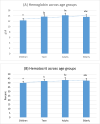Age, gender, and infectious status-wise assessments of hematological parameters among patients with dengue infection
- PMID: 39055808
- PMCID: PMC11269918
- DOI: 10.1016/j.heliyon.2024.e34053
Age, gender, and infectious status-wise assessments of hematological parameters among patients with dengue infection
Abstract
Background: The aim of this study was to examine the impact of different stages of dengue infection on immune cell counts among dengue patients and to compare them with cases of non-dengue febrile illness.
Methods: The recruited patients were divided into two groups: the first group served as a control (n = 55), representing non-dengue febrile illness, and the second group was identified as dengue febrile illness (n = 149), which was further divided into three groups based on infection stage. Blood samples were collected from the selected patients and subjected to blood cell component analysis. To find IgG and IgM as well as the dengue virus non-structural antigen-1 (NS1), an immunochromatographic test (ICT) kit was utilized. Additionally, a hematological analyzer was used to determine complete blood cell counts (CBC). Data was thoroughly analyzed using Graph Pad Prism 6 software. The differences in means of different groups were calculated by applying the student's t-test.
Results: The findings revealed the presence of severe leucopenia and thrombocytopenia at stages 1 and 2, accompanied by lymphopenia at stage 1. Group comparisons indicated that only teenagers exhibited a significantly lower white blood cell count compared to older individuals, while no significant differences were observed in lymphocytes, platelets, and monocytes across all age groups. Comparing different age groups of normal individuals to dengue-infected patients, the results unveiled that leucopenia was most severe in adults, followed by teenagers and children, with no significant difference in the elderly. Furthermore, adults showed the greatest degree of thrombocytopenia, followed by teens and kids, with the elderly showing the greatest degree of thrombocytopenia. Adults and teens showed extreme neutrophilia, whereas young children and the elderly showed no discernible abnormalities. Elderly patients experienced a marked decrease in monocyte count, a phenomenon not observed in other age groups.
Conclusion: In conclusion both, leucopenia & thrombocytopenia, are most severe in stages 1 and 2, whereas neutrophilia & lymphopenia are predominantly severe in stage 1. These results imply that the consequences associated with dengue infection are more severe in the early stages and tend to ameliorate as the patient progresses toward recovery.
Keywords: Dengue infection; Hematological parameters; Immune cell count; Infection control; Leucopenia; Thrombocytopenia.
© 2024 The Authors. Published by Elsevier Ltd.
Conflict of interest statement
Nil.
Figures









Similar articles
-
Emergence of travel: Associated dengue fever in a non-endemic, hilly state.Adv Biomed Res. 2014 Nov 29;3:239. doi: 10.4103/2277-9175.145744. eCollection 2014. Adv Biomed Res. 2014. PMID: 25538925 Free PMC article.
-
Correlation of serological markers and platelet count in the diagnosis of Dengue virus infection.Adv Biomed Res. 2015 Jan 30;4:26. doi: 10.4103/2277-9175.150396. eCollection 2015. Adv Biomed Res. 2015. PMID: 25709991 Free PMC article.
-
Severity of Dengue Viral Infection Based on Clinical and Hematological Parameters among Pakistani Patients.Am J Trop Med Hyg. 2023 Oct 23;109(6):1284-1289. doi: 10.4269/ajtmh.23-0309. Print 2023 Dec 6. Am J Trop Med Hyg. 2023. PMID: 37871589
-
Platelets in dengue infection: more than a numbers game.Platelets. 2022 Feb 17;33(2):176-183. doi: 10.1080/09537104.2021.1921722. Epub 2021 May 24. Platelets. 2022. PMID: 34027810 Review.
-
Thrombocytopenia in Dengue: Interrelationship between Virus and the Imbalance between Coagulation and Fibrinolysis and Inflammatory Mediators.Mediators Inflamm. 2015;2015:313842. doi: 10.1155/2015/313842. Epub 2015 Apr 27. Mediators Inflamm. 2015. PMID: 25999666 Free PMC article. Review.
References
-
- Park K.B., Patnaik H.H., Kim T.-Y., Jo Y.H., Kim N.-Y., Yang S.-C., Lee W.-G., Lee H.-I., Cho S.-H., Han Y.S. Current trends in large-scale viral surveillance methods in mosquitoes. Entomol. Res. 2020;50:292–308.
-
- Atif M., Raheel U., Alam F., Arshad H., Baloch F. Serotyping of dengue virus from deadly outbreaks of Pakistan. J Hum Virol Retrovirol. 2016;3:92–96.
-
- Jing Q., Wang M. Dengue epidemiology. Global Health Journal. 2019;3:37–45.
-
- Wang W.-H., Urbina A.N., Chang M.R., Assavalapsakul W., Lu P.-L., Chen Y.-H., Wang S.-F. Dengue hemorrhagic fever – a systemic literature review of current perspectives on pathogenesis, prevention and control. J. Microbiol. Immunol. Infect. 2020 - PubMed
-
- WORLD HEALTH ORGANIZATION . new edition. 2019. Dengue Guidelines for Diagnosis, Treatment, Prevention and Control. - PubMed
LinkOut - more resources
Full Text Sources

